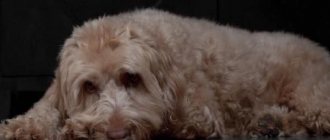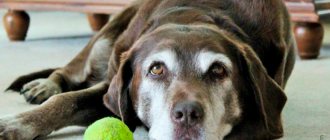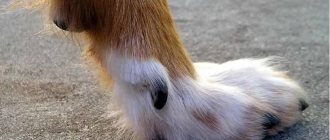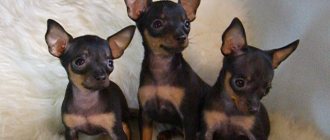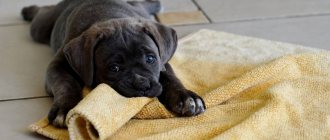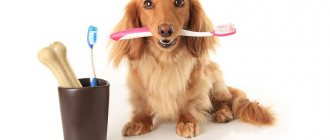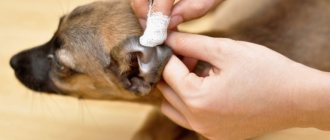How often should you brush your toy terrier's teeth?
You should start brushing your terrier's teeth no later than eight months of age; during this period, baby teeth are completely replaced by molars.
If baby canines, due to their short service life, do not have time to deteriorate significantly, molars without regular hygiene can quickly become covered with tartar. Tartar is a mineralized plaque that takes the form of a hard, dark crust on the tooth and increases in size over time. As a result of the formation of tartar, dogs experience bleeding gums, and their mouths begin to smell unpleasant. The result of the impact of tartar on a healthy tooth is its loosening and loss.
To prevent damage and loss of teeth in your toy terrier, you need to brush them regularly. This procedure should be carried out once or twice a week. It is better to have your toy terrier's teeth cleaned at a veterinary clinic. However, like trimming claws, this manipulation can be done at home; you can learn how to trim the claws of a toy terrier in this article (How to trim claws).
Toy Terrier coat care
Veterinarians advise bathing your toy terrier once every five to seven months , not more often, because the dog has dry, sensitive skin. If you have had any vaccinations or surgery, you should not wet your dog for at least 14 days.
Bathing water should be heated, and shampoo should be special for dogs. You can also buy an air conditioner. You should not overuse these hygiene products, as your dog may develop dandruff.
After bathing, the coat can be dried with a hairdryer. If the toy terrier is smooth-haired, then it needs to be combed with a brush or a special mitten; if it is long-haired, it should be combed with a comb or comb , preferably daily. Frequent and regular brushing will prevent felting and tangles.
In what order and at what months do puppies change teeth?
Newborn puppies are helpless. They are blind and toothless. During the first 2 months on mother's milk, they become completely independent.
Newborn puppies
Baby teeth begin to cut closer to the age of one month. Their number depends on the breed: for large ones - 32 pieces, and for dwarf ones - 28 pieces. The process is completed by two months from birth.
Need to know! Deviations from deadlines of 7-10 days are considered normal.
The incisors appear first, then the canines, and the premolars complete the row of baby teeth.
In time it looks like this:
- baby fangs appear on days 20-25;
- the incisors begin to appear after 10-15 days;
- premolars are the last to peck - by two months.
Attention! Decorative dogs (Chihuahua, Spitz) acquire milk teeth at the age of 1.5 months.
Milk teeth are evenly distributed throughout the jaws. Depending on the breed, there may be 14 of them on each jaw or 16. In the primary dentition there are no molars. They appear only after changing to permanent ones.
The beginning of the change of teeth starts almost immediately after the completion of the growth of milk teeth. Depending on the breed, food, and care rules, it is considered normal when this process is completed when the dog reaches one year of age.
Puppy milk teeth
The change of teeth occurs in stages, that is:
- first the incisors are replaced (3 months);
- then the fangs fall out (up to 7 months);
- premolars change.
Unlike the milk series, the permanent series is supplemented by molars. The first molars (M1) appear by 5 months, the second (M2) by 6 months, and the third (M3) by 7 months.
Dental care
If you don't take care of your four-legged pet's teeth, it may have problems. The presence of tartar has a serious impact on health. The reason for its appearance may be the lack of hard food in the diet (not bones, but carrots, apples, crackers). These products, when consumed, promote the natural removal of deposits during the chewing process.
Some owners consider this diet unacceptable for their dog. In this case, regular monitoring by a veterinarian is necessary. You can remove tartar yourself at home after a little practice. A special hook is used for this. They scrape off deposits after the dog's muzzle is securely fixed.
You can teach your pet from an early age to regular (once a week) teeth brushing. To do this, it is convenient to use a soft baby brush, placed on your fingers. You can also use baby paste, but it is better to purchase a special one at a pet store. How many teeth a dog will have during its life depends to some extent on its owner.
How is the new stage of growing up going?
The change of teeth in a toy terrier usually begins at the age of six months or a little earlier. By the time your dog is eight to twelve months old, all of her baby teeth should have fallen out. The owner of the toy terrier can help them fall out more easily by gently loosening them a little every day.
If you are planning to raise a show-class dog, which in due course will take an active part in exhibitions, then make sure that by the time she is eight months old (plus about two weeks), she has no milk left. teeth. If they do not fall out, you will have to seek help from a good doctor who will remove the remaining teeth.
At the same time, if you do not plan to study, then the rapid change of teeth in a toy terrier is not so important, and you may well wait until eleven to thirteen months to remove them. There is no point in delaying this any longer, because if baby teeth fall out much later than they should have, there is a high probability of getting misaligned teeth.
A sure indicator that the baby teeth have already outlived their usefulness are the molars, which have grown to half the size of the baby teeth.
A Toy Terrier's teeth begin to fall out at an average of six months. By the age of one year, the change of teeth in a terrier should be completely completed. If the owner purchased a toy terrier to participate in various exhibitions, then by the age of eight months the dog should not have any milk teeth left in its mouth. To do this, the owner will have to regularly loosen the pet’s teeth - this breed quite often has difficulty changing them.
If loosening does not help get rid of baby teeth, you and your pet need to visit a specialist to have them pulled out. Otherwise, the risk of deformation of the molars increases, which is why the animal will not be allowed to participate in exhibitions.
If the dog was bred “for the soul” and not for exhibition events, you can postpone visiting the veterinarian until the pet is one year old. By this age, in the vast majority of Toy Terriers, tooth loss occurs naturally. If a one-year-old puppy's baby teeth remain in his mouth, removal is inevitable.
You will have to visit the veterinary clinic if the terrier's teeth grow in two rows, that is, the milk teeth have not yet fallen out, but the molars have already come out. However, on the forums, breed owners advise postponing a visit to the clinic until the length of the molars reaches half the length of the baby teeth.
As the molars grow, the owner needs to carefully monitor this process. The correct bite in an adult representative of the Toy Terrier breed has a scissor shape - the upper incisors slightly overlap the lower ones. Due to an incorrect bite, the animal will not be able to participate in various competitions and exhibitions.
Owners are often interested in how many teeth a toy terrier has. According to breed standards, a terrier must have 42 teeth; you can study other standards for these pets in our other article.
If your pet has fewer teeth, there is no need to panic; this will, of course, be considered a disadvantage at exhibitions, but the pet will not be disqualified for this reason.
Timely oral hygiene is an excellent prevention of dental diseases in the Toy Terrier. However, it is worth remembering that a pet cannot take care of its health on its own, so the owner must take a responsible approach to the responsibilities of caring for the animal.
The condition of a toy terrier's teeth is not only a factor that increases the chances of winning at shows, but also a sign that your dog is healthy.
We suggest you familiarize yourself with How to build rooms for chickens - valuable tips
The miniature size of the breed does not mean that the toy has fewer teeth. They are the same as in a Caucasian - 42, 22 of which are in the lower jaw, and 20 are located in the upper jaw. There are four types of teeth - incisors, canines, molars and premolars, or they are also called molars and false molars.
The teeth of a toy terrier should be under the close attention of the owner, especially while the puppy is growing up. In order for miniature pets who take part in exhibitions and are simply favorites of the whole family to develop a healthy personality, the owner must take a direct part in oral hygiene and treatment of the chewing organs.
The timing of the appearance of all permanent teeth does not depend on the breed of the dog. All dogs grow them by the age of one year. But the change itself proceeds differently in different breeds. Small dogs are in the process for the entire first year, and large breeds have the entire series by 9 months.
That is, adults must have 42 teeth: 20 in the upper jaw and 22 in the lower jaw. The upper jaw consists of:
- molars – 4;
- premolars – 8;
- fangs – 2;
- incisors – 6.
In the lower jaw:
- molars – 6;
- premolars – 8;
- fangs – 2;
- incisors – 6.
Changing teeth is a big challenge for the animal and its owner. Problems can be noticed by the pet's behavior. When dogs change their teeth, their relationship with food changes. They prefer something softer or more liquid. The owner needs:
- regularly examine the puppy’s jaw;
- provide him with rubber toys, such as sticks, bones;
- give peeled carrots (and vitamins at the same time);
- regulate the presence of phosphorus and calcium in the diet.
If necessary, you can gently loosen a loose tooth (but do not pull it out by force).
Feeding the puppies
is very important! During the period of changing teeth, the puppy should be provided with peace and protected from contact with other pets. Vaccinations are not indicated during this period.
In order for teeth to grow correctly, you need to monitor the process of the appearance of each of them. It often happens that the permanent one begins to grow before the milky one falls out. You cannot force toys or any other object out of your pet’s mouth or play tug-of-war with it. It is better to feel the teeth every day and slightly loosen them as they sway.
When puppies lose their baby teeth, adjustments are also made to their diet. It is better to leave very hard foods until better times. The dishes must be clean and the water must be fresh. For any deviations, you should contact a specialist.
When puppies change their teeth, they experience discomfort, sometimes quite severe. The pet may refuse to eat altogether. This means that the food needs to be changed. To keep your pet healthy, it should be switched to something between semi-liquid and liquid food. Sometimes the puppy can only lap or lick. In this case, he needs to be given broths and fermented milk, meat and vegetable puree.
Important! You can use special dog food. But only very high quality and in the form of pate.
Replacing baby teeth with permanent teeth
The development of a puppy’s dentition is a long process, accompanied by serious stress for the body.
Proper bite and teeth growth plays a key role in a dog's health throughout its life. The process of teeth formation and eruption is divided into stages that the owner needs to monitor. You've probably noticed that puppies' milk teeth are very sharp. What is the reason? Many people believe that the reason for sharp teeth is obvious - the puppy must be able to tear and chew meat. Research by zoologists has shown that there are two more equally important reasons: natural weaning from mother's milk and the acquisition of skills to control the clenching of the jaws during a bite.
The mother feeds the puppies exclusively with milk until they are one month old, after which the babies begin to develop sharp teeth. Causing discomfort to the mother, babies are increasingly denied milk when they want to suckle and are forced to look for other sources of food. During play, puppies bite. Because their teeth are very sharp, strong clenching of the jaws leads to conflict situations and interference from the mother.
Almost all puppies are born without teeth; in rare cases, babies have incisors immediately after birth. Born completely helpless and toothless, the puppies are under the full care of their mother.
At about 2-3 weeks, the puppy's baby teeth begin to erupt. The pattern of changing baby teeth in puppies presupposes a certain order of eruption, but its disruption while maintaining the correct bite does not play an important role. Baby teeth grow in for a period of time until the puppy is ready to eat adult food.
The standard pattern for the eruption of baby front teeth looks like this:
- Middle central incisors on the lower and then on the upper jaw.
- Lateral incisors on the lower and then on the upper jaw.
- At about one month of age, the puppy's fangs erupt. According to the scheme, the lower and then the upper canines should erupt. In fact, canine growth can occur in any order.
Sharp fangs become the first obstacle to continuing to suck the mother's milk. Experiencing hunger, against the backdrop of heightened senses, puppies begin to look for alternative sources of food. At this time, the breeder introduces supplementary feeding.
Depending on the breed, genetic characteristics, quality of feeding and the number of puppies in the litter, premolars (the teeth that are located immediately behind the canines) begin to erupt between 3 and 6 weeks of age. There should be 12 premolars in total - 6 on the bottom and 6 on top. By 8 weeks of age, the puppy’s dentition consists of 28 teeth:
- 12 incisors.
- 4 fangs.
- 12 premolars.
The standard scheme for changing baby teeth to molars is as follows:
- At the age of 3 to 4 months - replacement of the front incisors; usually, the lower incisors fall out first, then the upper ones.
- By the fifth month, the puppy should have all its molars.
- At the age of 5.5 to 6 months, the puppy’s fangs begin to change. The fangs may begin to grow, but may not fully grow for several months.
- From 6–7 months, the replacement of premolars begins.
Normally, by the age of 7 months, a puppy should have lost all 28 baby teeth. At the age of 8 to 10 months, the puppy should have all its molars, 42 in total:
- 12 incisors.
- 4 fangs.
- 16 premolars.
- 10 molars.
The change of teeth in a dog starts as soon as the first milk teeth firmly take their places, i.e. approximately from the end of 3 months. It is impossible to say exactly how many months the change occurs - usually we are talking about the full first year of life. Those. milk teeth are completely replaced by permanent ones by the end of the first year of life or up to 9 months in large and medium-sized dogs and 10-11 months in small ones. At one year of age, a dog of any breed should already have permanent, strong, white and sharp teeth.
- 12 incisors (6 pieces on top and bottom);
- 4 sharp, slightly curved canines (2 on each jaw, immediately behind the incisors);
- 16 premolars (8 pieces on each jaw or 4 pieces on each side above and below);
- 10 molars (top 4 - 2 on each side, bottom 6 - 3 on each side).
In the primary dentition there are no molars or extreme premolars. The difference between a baby set of teeth and a permanent set is 10 or 14, depending on the breed.
The change does not occur in the order in which the dairy plants began their growth:
- first the incisor hooks fall out, then the middle ones and the edges (from the 4th to the end of the 5th month);
- the first molars grow immediately behind the premolars, which did not have a “milk” base - they do not allow the dentition to shift at the time of replacement of false molars;
- are replaced by permanent premolars (6-8 months);
- the change of fangs ends at 6-7 months - simultaneously or after the premolars;
- All other (new) molars grow in (7-9 months).
In large breeds and simply large dogs, the change occurs somewhat faster than in small, decorative dogs (but up to 1 year). This is explained by the fact that in small breeds the teeth often do not have time to fall out before the molars begin to grow underneath them. That is why small dogs need to have their mouths regularly examined to prevent deviations in the change of teeth during the first year of life.
Why do you need to know how many months a dog’s teeth change? This process significantly affects the state of the animal’s immune system. During this period, no vaccinations are carried out, and veterinarians strictly announce the time for repeated vaccinations - after changing teeth!
By the end of the first year of life, the dog has formed a healthy, strong, permanent grin of 42 teeth. Any deviation in quantity, both up and down, indicates disturbances in the intrauterine development of puppies or mutations at the genetic level. After changing during life, the color changes from white to slightly yellowish (baby teeth in dogs have a pearly white tint).
We suggest you read: What food is best to feed your Sphinx, buy premium food for Sphinxes
The angle of growth of the teeth and the contact of the upper and lower jaws (bite) varies somewhat among different breeds of dogs. Deviation from the normal location has its own name.
With age, older dogs experience wear of dental crowns and grinding of fangs. With proper bite, wear occurs evenly and does not affect the quality of life of even elderly dogs.
- undershot;
- pincer-shaped (or straight);
- scissor-shaped (or normal);
- bulldog-shaped;
- snack.
A dog's teeth must be replaced once during his entire life and only in the milk series. Indigenous ones grow once and cannot be replaced. Any loss of a permanent tooth in a dog over 1 year of age clearly indicates some kind of health problem.
Does this terrier need to have his teeth pulled?
Features of the Toy Terrier breed include a predisposition to anomalies when changing the chewing organs. This applies to all dwarf decorative dogs weighing up to four kilograms. Already at the genetic level of these pets there is no natural (independent) replacement of primary premolars and incisors with permanent ones, and also:
- Dogs of dwarf breeds, which include the terrier, have a narrow jaw, so the chewing muscles are poorly developed.
- The period of replacement of temporary with permanent chewing ones in a terrier falls during the active development of the jaw itself.
- The puppy’s diet may be low in calcium, or calcium may not be sufficiently absorbed by the animal.
- Like no other breed, the small teeth of the toy terrier are prone to incorrect positioning of the buds, since the molars and molars do not fit in the small jaw.
Owners of tiny dogs should be prepared for this problem, and consider the question of whether the terrier needs to have its teeth pulled out as a necessity. Otherwise:
- a delay or disruption in the process of replacing milkmen with roots can provoke a disease called polydentia. This is when in the terrier’s mouth the teeth exceed the natural number due to the simultaneous presence of temporary and permanent premolars and incisors.
- untimely or not pulled out milk jugs are the cause of the development of dystopia - incorrect arrangement of molars and false molars.
- A particular danger for a miniature dog are displaced fangs, which in the future will become a source of injury to the hard palate, lips, jowls and tongue. In this case, the pet develops ulcers in the oral cavity that bleed and cause pain.
If you notice that a molar, premolar or molar has grown to half its size, then the temporary chewing organ should obviously be pulled out.
If you do not pull out the primary premolars and incisors, which have not fallen out on their own and are interfering with the growth of the molars, then you are guaranteed to have further development of tartar or caries. Naturally, exhibitions are out of the question.
A veterinarian dentist removes the temporary chewing organs of a toy terrier under general anesthesia or using local anesthesia:
- local anesthesia does not cause as much harm to the pet’s health compared to general anesthesia, but the dog feels pain during local anesthesia.
- general anesthesia is a more humane method, but a small terrier often takes a long time to recover from the state of anesthesia.
The process of removing baby teeth from a toy terrier
Veterinarians usually offer two options for removal: under general anesthesia and under local anesthesia. Each of them has a number of disadvantages. First: the long process of coming out of anesthesia; the possibility of death or the development of serious illnesses. Disadvantages of local anesthesia: even with anesthesia, the toy terrier may feel pain during surgery. This depends on the structural features of the teeth and the length of their roots.
The best way to remove baby teeth from a toy terrier should be decided by the doctor, having previously analyzed the dog’s health. Most veterinarians prefer general anesthesia as it is considered convenient and humane.
When asking how many teeth a dachshund dog has, the answer you will get is the same as for any other breed. According to experts, the number of teeth is the same in all species. However, there is an opinion that decorative breeds may not have a complete set of them.
Then how many teeth does a Chihuahua dog have? Normally, there should still be 42 of them. But it is possible that two small molars are missing in the lower jaw. Such conventions are associated with the admission of animals to exhibitions and competitions. For the dog itself, their absence is unnoticeable and does not affect nutrition.
Let's consider another decorative breed and answer the question “how many teeth does a dog have?” in relation to it. The Toy Terrier may have “extra” teeth. So, when examining the mouth of a dog of this breed, you can observe additional rows of incisors or premolars. It is necessary to distinguish the milk set that has not yet fallen out from permanent extra teeth.
The veterinary clinic will offer you two removal options:
- using local anesthesia,
- under general anesthesia.
We invite you to familiarize yourself with the Boston Terrier: photo, description, diseases, character, breed standard
Each method has its drawbacks. The disadvantages of the first option include the fact that the toy may experience pain during surgery, even when using a local anesthetic. A lot depends on the length of the roots, so it is best to consult a dentist and listen to his opinion.
Disadvantages of the second option:
- Toys can take a long time to recover from anesthesia (but also often Toys fully recover within an hour or two),
- general anesthesia can be harmful
- the doctor will warn you about the possibility of death.
It is worth noting that in most veterinary clinics, general anesthesia is used during tooth extraction surgery, as this is much more convenient and humane.
After changing teeth, the Toy Terrier should have a scissor bite, in which the upper teeth (incisors) slightly cover the lower ones. If a dog has an incorrect bite, it is disqualified from the exhibition and is not allowed to breed. Malocclusions include:
- undershot, in which the lower jaw is much longer than the upper and protrudes forward,
- undershot, when the upper jaw protrudes strongly forward,
- pincer bite, in which the lower and upper rows of the front teeth are in contact with each other,
- alveolar inclination of the incisors, when the front incisors grow at an angle, and not vertically, as they should be.
The bite of a toy terrier can change during the change of teeth, since at this age the jaws are still growing, and the teeth themselves can change their position, since they are not yet firmly in place.
Veterinarians usually offer two options for removal: under general anesthesia and under local anesthesia. Each of them has a number of disadvantages. First: the long process of coming out of anesthesia; the possibility of death or the development of serious illnesses. Disadvantages of local anesthesia: even with anesthesia, the toy terrier may feel pain during surgery. This depends on the structural features of the teeth and the length of their roots.
The best way to remove baby teeth from a toy terrier should be decided by the doctor, having previously analyzed the dog’s health. Most veterinarians prefer general anesthesia as it is considered convenient and humane.
That terrier's teeth are falling out
The problem of loose and falling out molars is common in small breeds. This mainly occurs between the ages of one and two years. The dog should be immediately shown to a veterinarian dentist so that he can determine the reason why the bone tissue is being destroyed. And the main reasons are the following:
- dental plaque, which is initially soft and then hardens, turns into tartar and destroys the masticatory organ.
- Gingivitis is a disease of the oral cavity in which the gums become inflamed. Advanced gingivitis leads to gum atrophy, the formation of periodontal canals and, accordingly, tooth instability.
- periodontitis - the duration of inflammation of the gums is accompanied by bleeding, discharge of pus, pain for the pet when chewing food, and a putrid odor from the mouth. The pet eats poorly, loses weight, and becomes aggressive. Asymmetry of the muzzle may appear.
As soon as you notice that your terrier's teeth are falling out, rush to the doctor. Only timely help and painstaking adherence to the dentist’s recommendations will stop further loss and loosening of the masticatory organs.
The dog owner’s task is to prevent loosening and tooth loss, which consists of:
- regular cleaning of each tooth with special pastes and brushes for dogs.
- the correct diet of the animal, which must include solid foods (apples, carrots, fresh beets, crackers and a special crunch).
The change of teeth in a toy terrier begins at approximately six months of age. By a year or a little earlier, this process should be completely completed. Losing baby teeth is not the most pleasant period in the life of any mammal, be it a dog or a human. If the owner needs information related to changing the pet’s teeth, we are ready to provide it in full.
When should a toy terrier's baby teeth be removed?
If you plan to exhibit your dog at dog shows in the future, then be prepared to learn the basics of dentistry. By the age of eight months, the dog should have no baby teeth left. In the process of changing them, you must help the animal by rocking them little by little. If the toy terrier’s baby teeth do not fall out by the required date, then you will have to take the baby to the doctor, who will pull out the remaining ones under anesthesia.
If you do not plan to breed puppies, then whether the toy terrier’s teeth fall out on time or not does not really matter. You can hold off on forced removal and wait until your dog is 12 months old. By this time, a complete change of teeth occurs in 90% of toy terriers. If, after reaching a year, some of the dog’s milk teeth remain in place, then they will have to be removed so that the defect does not lead to difficulties in chewing food.
If you plan to exhibit your dog at dog shows in the future, then be prepared to learn the basics of dentistry. By the age of eight months, the dog should have no baby teeth left. In the process of changing them, you must help the animal by rocking them little by little. If the toy terrier’s baby teeth do not fall out by the required date, then you will have to take the baby to the doctor, who will pull out the remaining ones under anesthesia.
If you do not plan to breed puppies, then whether the toy terrier’s teeth fall out on time or not does not really matter. You can hold off on forced removal and wait until your dog is 12 months old. By this time, a complete change of teeth occurs in 90% of toy terriers. If, after reaching a year, some of the dog’s milk teeth remain in place, then they will have to be removed so that the defect does not lead to difficulties in chewing food.
How to help a puppy with teeth changes
How to help your puppy when changing teeth, relieve discomfort, avoid complications and protect your own things from “toothies”? In nature, canines get rid of their baby teeth in a quick and primitive way - they chew sticks and stones. The puppy will do the same if given the opportunity.
When living in an apartment, you need to make sure that the puppy has something to chew on. To prevent inflammation and delayed tooth change, the baby’s mouth should be examined daily.
You should be wary if:
- The gums turned red not only along the edge of eruption.
- An unpleasant odor appeared from the mouth.
- Teeth changed color.
- Gums are bleeding.
Contact your veterinarian immediately if your puppy has a fever or has completely refused to eat. In all other cases, as long as the pet’s health does not cause suspicion, your task is to feel sorry for and distract the pet.
What kind of bite should a Toy Terrier have according to the breed standard?
The owner must control the growth process of permanent teeth. An adult dog's bite should be a scissor bite. The upper incisors should slightly cover the lower ones. Incorrect bite leads to the inevitable disqualification of the animal from exhibitions and competitions. Here are its main features:
- undershot – the lower jaw protrudes forward, being longer than the upper jaw;
- undershot – protrusion of the upper jaw forward;
- pincer bite – when the surfaces of the upper and lower front teeth touch;
- incisor inclination - when the front teeth do not grow vertically, but at an angle.
During the process of changing teeth, the bite of a toy terrier can change, because at this time the puppy’s jaw is still developing and the teeth, which have not yet had time to firmly fall into place, can easily change position.
We suggest you read Why a cat is going bald and how to stop hair loss
The owner must control the growth process of permanent teeth. An adult dog's bite should be a scissor bite. The upper incisors should slightly cover the lower ones. Incorrect bite leads to the inevitable disqualification of the animal from exhibitions and competitions. Here are its main features:
- undershot – the lower jaw protrudes forward, being longer than the upper jaw;
undershot – protrusion of the upper jaw forward;
pincer bite – when the surfaces of the upper and lower front teeth touch;
incisor inclination - when the front teeth do not grow vertically, but at an angle.
During the process of changing teeth, the bite of a toy terrier can change, because at this time the puppy’s jaw is still developing and the teeth, which have not yet had time to firmly fall into place, can easily change position.
Removal of diseased teeth
Veterinarians recommend removing diseased teeth, as they contain an infection that can lead to various bacterial complications. Pathogenic bacteria quickly destroy tooth tissue, gum suppuration begins, and the inflammatory process can affect the jaw bones.
Have your tooth removed by a veterinarian
Tooth extraction is also necessary in case of jaw injury, or when a tooth is broken or crushed. The animal experiences acute pain, so most often the teeth are removed under anesthesia . The dog is in an unconscious, immobilized state for some time, which allows the veterinarian to perform all the necessary manipulations.
In almost all cases of tooth extraction in an adult dog, the doctor performs a resection of the adjacent gum tissue, since the roots are located very deep. An exception is the removal of loose teeth affected by periodontal disease or after gingivitis. Such teeth are weakened, do not hold well in their sockets and can be removed even without anesthesia.
The cost of removing a diseased tooth in an adult animal depends on the size of the dog and the complexity of the upcoming operation. Most often, the price for removal starts from seven hundred rubles, but if the tooth is loose and the dog does not require anesthesia, then on average the owner will have to pay about five hundred rubles.
Possible complications
When changing teeth, various complications can arise. Small breeds weighing up to 8 kg are especially predisposed to them. Troubles most affect medium-sized and long-faced breeds, such as:
- lap dogs;
- toy terriers;
- Yorkies (Yorkshire terriers, for example)
- Italian greyhounds;
- poodles;
- Sheltie
These dogs were artificially bred specifically for home keeping. They never had to look for food for themselves. They eat what their owner gives them. These are often soft canned foods. There is no need to train the chewing muscles, so the gums weaken. Moreover, they are dogs, that is, they have ordinary teeth, of ordinary sizes.
Long-faced dogs
This dissonance leads to the fact that baby teeth do not naturally loosen and fall out, while permanent teeth rush to appear on time. Baby and permanent teeth sitting in the same hole lead to improper growth of the latter, and, as a result, to malocclusion. You can't do it without the help of a specialist.
With some clarifications, this problem also applies to large breed dogs. The reasons are almost the same. Complications arise with breeds:
- boxers;
- mastiffs;
- Caucasians;
- Great Danes;
- Shepherd dogs (German, Eastern European);
- Labradors;
- husky;
- miniature schnauzers;
- Dobermans;
- Rottweilers.
You can tell if there are problems by:
- improper jaw closure;
- bleeding gums, swelling in this area;
- heavy odor;
- purulent fistulas under the nose.
There is also a possibility of missing teeth. This is already a pathology, nothing can be changed here.
As for the causes of complications, these could be:
- Inflammation of the gums. It can occur when teeth erupt too large and leathery pockets form on the gums (food remains and rots).
- Persistent teeth - when permanent teeth come out in parallel with milk teeth. In this case, baby teeth begin to rot, which leads to inflammation.
- Diarrhea. This is rather a concomitant phenomenon. If it happens, you need to monitor the drinking regime and the hygiene of your pet’s household items.
- Smell from the mouth. It appears as a result of rotting food under the gums and rotting of the tooth itself.
- Poor appetite. This phenomenon is very explainable. If there is pain in the oral cavity, then the discomfort is stronger than the desire to eat. During the normal course of the teeth changing process, appetite will return very soon.
Malocclusion
An incorrect bite in a dog can be a consequence of incorrect actions by the owner or depend on the breed characteristics. You can notice the symptoms visually - the jaws will close incorrectly. If this is not critical for ordinary pets, then for show pets it is definitely a rejection.
Malocclusion
According to the breed, this affects dogs with an elongated jaw (muzzle). Their teeth are of normal size and their gums are narrow. For example, these include:
- Doberman;
- spaniel;
- dachshund;
- poodle;
- corgi;
- beagle;
- Rottweiler;
- Labrador;
- Scotch Terrier;
- Jack Russell Terrier;
- French Terrier.
The pattern of feeding and play communication with the pet depends on the person. An incorrect bite can result from feeding soft foods or mechanical intervention (pulling objects out of the mouth).
If improper closure of the jaws is detected, the dentition should be checked for missing milk teeth. If you can’t cope on your own, you need to contact a veterinarian. He will be able to remove the tooth, possibly with the use of anesthesia.
Braces
Note! For show animals it is possible to install special braces.
There are breeds that almost always have dental problems. These are Pekingese and bulldogs. They have a deformed jaw from birth. Teeth grow randomly. In order not to lead to periodontitis, they need especially careful care.
How can the process of changing teeth be complicated?
Malocclusion
Incorrect replacement of teeth or unreasonable human intervention in the process can provoke an incorrectly developing bite in dogs. Also, dogs with elongated muzzles, when teeth of a standard size are placed on narrow gums (Doberman Pinschers, Poodles, Rottweilers, Labradors, Scotch Terriers, etc.), are prone to this problem.
- Symptoms. Incorrect closure of the jaw is detected.
- Help. If the bite is broken, then for purebred dogs this is a significant drawback when they participate in exhibitions. You can try to install special braces to correct it, which are installed by specialists under anesthesia. Ordinary domestic dogs are usually not subjected to this procedure and the bite remains as it is.
Gum inflammation
Often a minor inflammatory process accompanies the entire period of tooth change. Usually everything goes away on its own. If there is a complication, you need to go to the clinic.
- Symptoms. The gums are intensely red and swollen, saliva flows heavily, and there is a high probability of decreased appetite due to sore gums.
- Help. Avoid rough food so as not to cause additional trauma and pain in the mouth.
When inflammation persists, to sanitize the oral cavity in dogs, as prescribed by a veterinarian, you can use the drug “Stomadex” C300 in courses of 10 days (cost: 400-450 rubles/pack with 10 tablets). The tablet from the package is pressed with your finger onto the dry surface of the cheek at the level of the 2nd premolar. Dry the cheek with a clean, dry paper towel.
Sometimes baby teeth don’t have time to fall out before permanent ones “make their way” into their place. In addition to malocclusion, persistent teeth threaten additional injuries to the cheeks and inflammation of the gums.
- Symptoms. Milk teeth are discovered at an age when they should no longer exist, as well as two processes from approximately one tooth socket (one of them is milk teeth).
- Help. If, with a loose baby tooth, the owner cannot help it fall out without effort, this is a reason to contact a veterinarian - it will be removed using anesthesia.
We invite you to read: Training and education of Yorkie puppies and adult Yorkshire terriers
Toy Terrier teeth - compliance with the standard
According to the breed standard, a dog must have all teeth. There are 42 of them in total (incisors, canines, molars and false molars). If your dog is missing teeth, don't panic ahead of time. Of course, judges and experts assess this as a disadvantage. But, fortunately, it is not a disqualifying defect.
Since the dog does not have the ability to independently take care of oral and dental hygiene, this task falls on the shoulders of the owner. A responsible approach to the health of your toy terrier will not only significantly improve the quality of his life, but also extend its life.
According to the breed standard, a dog must have all teeth. There are 42 of them in total (incisors, canines, molars and false molars). If your dog is missing teeth, don't panic ahead of time. Of course, judges and experts assess this as a disadvantage. But, fortunately, it is not a disqualifying defect.
Since the dog does not have the ability to independently take care of oral and dental hygiene, this task falls on the shoulders of the owner. A responsible approach to the health of your toy terrier will not only significantly improve the quality of his life, but also extend its life.
